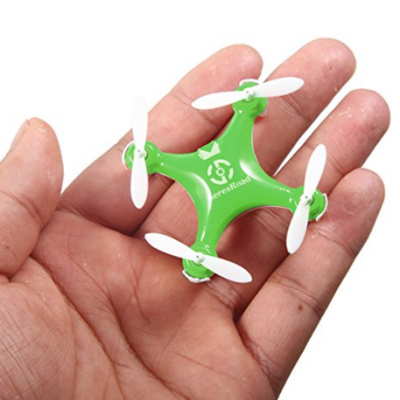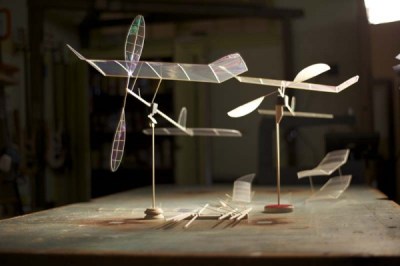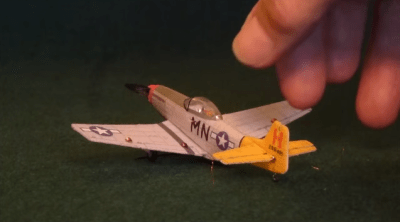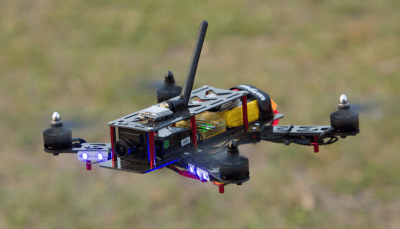New FAA rules are making radio-controlled aircraft a rough hobby to enjoy here in the USA. Not only are the new drone enthusiasts curtailed, but the classic radio-controlled modelers are being affected as well. Everyone has to register, and for those living within 30 miles of Washington DC, flying of any sort has been effectively shut down. All’s not lost though. There is plenty of flying which can be done outside of the watchful eye of the FAA. All it takes is looking indoors.
Living Room Flights
 When flying sorties in the living room, a rotary wing aircraft is your best friend. Back in the 90’s, I used to dream of a quadcopter which was small enough to fit in the palm of my hand. Today, thanks to motor and battery advances, they’re everywhere. You can buy a palm-sized quadcopter at your local mall for under $20 USD. Many of these are based on the Cheerson CX-10 design, which weighs in at a miniscule 11.9 grams. These are actually great flying quads, with 3 “skill levels” which actually translate to transmitter stick sensitivity changes. The only downsides to them are flight time and orientation. Beyond 10 feet or so, it’s easy to lose orientation with an object barely an inch on a side. The on-board LEDs help with this, but eventually the red and blue blend into a purple blur.
When flying sorties in the living room, a rotary wing aircraft is your best friend. Back in the 90’s, I used to dream of a quadcopter which was small enough to fit in the palm of my hand. Today, thanks to motor and battery advances, they’re everywhere. You can buy a palm-sized quadcopter at your local mall for under $20 USD. Many of these are based on the Cheerson CX-10 design, which weighs in at a miniscule 11.9 grams. These are actually great flying quads, with 3 “skill levels” which actually translate to transmitter stick sensitivity changes. The only downsides to them are flight time and orientation. Beyond 10 feet or so, it’s easy to lose orientation with an object barely an inch on a side. The on-board LEDs help with this, but eventually the red and blue blend into a purple blur.
For those learning to fly indoors with a multicopter, or just looking for something a bit bigger than the CX-10, I always recommend the Hubsan X4. The larger size makes them easier to see, and a bit more stable. You can even pick up a prop bumper, which will ensure the props never hit the walls, windows, people, or anything else fragile. These little props do sting a bit if they catch skin, but they don’t have enough mass to do any real lasting damage.
The tinkerers and hackers out there will be happy to know that some of these tiny quadcopters are hackable. Some commercial quadcopters can be hacked with BradWii, a port of the Multiwii quadcopter software. You can even start from scratch, buying individual parts and 3D printing a frame. Check out Micro Motor Warehouse for some great info on this option.
Indoor Meetups and Competitions
Model aircraft enthusiasts have been flying indoors just as long as they have outdoors. In colder climates, clubs often work with local schools or community centers to get weekly access to an indoor space. Any building with a large open space becomes a flying site. There are plenty of commercial planes available to fly indoors. A great example is the Vapor. Stunt planes capable of 3D flight are also common. Helicopters, tricopters, quadcopters, even the odd gyroplane or ornithopter can also be found at these indoor meetups. It’s not hard to find your local flying club – in the USA, just check the AMA club search page. If you strike out there, check Google.
 The model plane folks haven’t just been flying all these years. Many of them constantly push the envelope. Lower weight, smaller size, longer flight time, and I’m not just talking about radio control. Rubber powered airplanes invoke images of balsa toy store planes. The competitive indoor crowd has evolved from there to F1D, which is the indoor duration competition class. Impossibly light free flight planes that can fly for an hour or more without any user input – all powered by a few turns of a rubber strip. Seeing is believing with these planes, and the flight test folks have a great video with [Joshua Finn], an F1D record holder, that explains it all.
The model plane folks haven’t just been flying all these years. Many of them constantly push the envelope. Lower weight, smaller size, longer flight time, and I’m not just talking about radio control. Rubber powered airplanes invoke images of balsa toy store planes. The competitive indoor crowd has evolved from there to F1D, which is the indoor duration competition class. Impossibly light free flight planes that can fly for an hour or more without any user input – all powered by a few turns of a rubber strip. Seeing is believing with these planes, and the flight test folks have a great video with [Joshua Finn], an F1D record holder, that explains it all.
 The R/C plane groups have also produced some incredibly tiny craft. How about a fully functional 3 channel (Throttle, elevator, rudder) plane that weighs in below 1 gram? The secret sauce is in the servos – or lack thereof. These planes fly with actuators, which are nothing more than a couple of coils of magnet wire and a tiny neodymium disc magnet. Passing a current through the wires causes the magnet to twist. PWM allows the current and thus the amount of twist to be controlled. Some careful building techniques allow this simple motion to be coupled to the plane’s control surfaces. In many cases, the electronics are either custom-made, or come from small online shops like Micro Flier Radio Folks like [Martin Newell] have come up with impossibly small, incredibly light flying machines using these techniques. Each one is a work of art.
The R/C plane groups have also produced some incredibly tiny craft. How about a fully functional 3 channel (Throttle, elevator, rudder) plane that weighs in below 1 gram? The secret sauce is in the servos – or lack thereof. These planes fly with actuators, which are nothing more than a couple of coils of magnet wire and a tiny neodymium disc magnet. Passing a current through the wires causes the magnet to twist. PWM allows the current and thus the amount of twist to be controlled. Some careful building techniques allow this simple motion to be coupled to the plane’s control surfaces. In many cases, the electronics are either custom-made, or come from small online shops like Micro Flier Radio Folks like [Martin Newell] have come up with impossibly small, incredibly light flying machines using these techniques. Each one is a work of art.
Off to the Drone Races
 Those who feel the need for speed have discovered FPV drone racing, one of the newest aspects of the hobby. Racers are usually 250 mm class (and smaller) quadcopters running 5-inch propellers. At full speed these craft are way too fast for the average gym. However, plenty of racers have set up courses in local parking garages. The hard part here is making friends with the property owner. I’d recommend showing him the drones – and offering to let him or her have a “fly along”, watching on a second pair of video goggles. Who knows, they might be bitten by the R/C bug and join the races.
Those who feel the need for speed have discovered FPV drone racing, one of the newest aspects of the hobby. Racers are usually 250 mm class (and smaller) quadcopters running 5-inch propellers. At full speed these craft are way too fast for the average gym. However, plenty of racers have set up courses in local parking garages. The hard part here is making friends with the property owner. I’d recommend showing him the drones – and offering to let him or her have a “fly along”, watching on a second pair of video goggles. Who knows, they might be bitten by the R/C bug and join the races.
Desktop Pilots
If you really want to burn holes in the sky, and aren’t interested in indoor flight, there is always the simulator option. Radio control modelers have been flying from their desktops since the 1980’s. Modern simulators can utilize a computer interface, which ties a modelers transmitter to the PC. This makes the experience even more immersive. Commercial offerings like Real Flight and Phoenix are the most popular, though there are freeware offerings as well, such as FMS. There are even full featured mobile apps on android such as FPV Freerider which allow you to get in some stick time away from home.
These sims really shine when you’re first learning to fly. Training your brain to instinctively handle things like nose in flight takes time and practice. The simulators offer a crash free (or is that free crash?) way of doing that. Tipping over an R/C helicopter is expensive – both in money and time. Tipping over in the sim is fixed with a click of the mouse. Keep an eye on system requirements when looking at this software. Everything is going toward photorealistic scenery, so these programs can use high-end gaming cards if you have them. If you aren’t a card carrying pro gamer, turning the details down and flying on a lower-spec machine will certainly get the job done as well.
So no matter what happens with the FAA or other governing bodies, get out there and do your best to fly every day, even if it’s only a couple of laps around your living room.















or why not violate the law and fly outdoors.
what’s the worse that can happen? the police takes your model away so buy a new one and repeat
“what’s the worse that can happen? ”
In the US?
Depends on your skin colour.
1 count of having fun without someone bleeding money off your experience
1 count of being brown in the USA
1 count of complaining about some miserable paranoid loser policies
3 strikes, and you’ll never get out of prison in the USA.
…but a quad may still deliver weed over the fence…
=P
$10,000 fine and lose your drone?
More like $27,000 fine for civil charges (and confiscation I would imagine)
Or ‘criminal charges’ of $250,000 and 3 years in prison.
Dont forget the whole “I feared for my life” spiel, with possible loss of life and limb accompanying that.
Who ever came up with the fines is a sadistic SOB who probably drowns puppies as a hobby.
The worst that can happen is that FAA could succeed in slapping you with a $27,000 fine and 3 years in jail for flying without registering. At least, that’s what I remember from the FAA’s announcement.
Sorry… 3 year jail time is only for criminal penalties. Civil penalty is up to $27,500. Read more here: http://www.faa.gov/uas/registration/faqs/
Surely the FAA istself is breaking the FAA Modernization and Reform Act of 2012 (Section 336) by requiring registration of remote control aircraft that weigh less than 55pounds?
I’m not sure how sure how acting expressly against an act of congress can be considered lawful, even for a federal agency.
Thank you. The AMA’s rules have worked just fine for us who are involved for what, 60+ years?
if I’m flying below the treeline and on my own property, good luck catching me. you can’t go out your door without breaking some law you have no knowledge of. if you’re not harming anyone, go do it.
or, if you’d like to cause some mayhem..go to the “drone registry” and put someone else’s registration number on your drone. if caught, deny deny deny.
If you keep it under 83 feet, the FAA has no authority. If you keep it under 400 feet and away from airports and other restricted areas, the FAA has very sketchy questionable authority. But then it’s the U.S.A. government and when have they ever been concerned with following the law.
What are “they” afraid of? Someone dropping rotten eggs on government buildings?
Just recently the “new” 2015 dietary guidelines came out: same old. May more million of US citizens will be driven into T2 diabetes, current sufferers will get feet chopped off and finally die prematurely due to bad and outdated advice. And the most important thing your government can think of is going paranoid on recreational drone operators.
WTF!?!
The government isn’t a single body. It’s made of several bodies. The FAA gives no shits about your insulin levels.
There’s so much compassion in what you say. I almost envy your fellow citizens.
a better question is..why is the government if the business of dietary advice AT ALL? how much money did they waste on that particular division that could have gone to something actually useful?
Oh my god! Last time I went to L.A. to visit family my brother in law and has friends gave me lecture in “U.S.A. – the country that allows everything from shooting stuff to riding big cars with huge motors” and they all agread that Germany sucks because you will not even find a car shop where you can buy a (serious) pickup.
And now this! I mean honestly – you are allowed to fly a lightweight plane with what? An old bus ticket? An expired driving license? Bur you are not allowed to fly a model aircraft without registering?
This is so ridiculous!
As soon as its getting warmer I am going to go outside with my tricopter and my wife and I will fly FPV around her while she is wearing a tight shirt showing her nipples!
Well that escalated quickly…
+1 !!!!! Made me chuckle!!! :-)
Hihi, well said.
Hab eine gute Saison und fange nie den letzten Akku an, der macht ‘Stecklandung’.
so, when are you going to post this particular protest video?
Kites are still permitted with in the DCSFRA. Kite with payloads up to 5lbs are permitted without restriction.
SO you are saying if I tie a string to my drone, I don’t have to register!!
Seriously? The FAA rules are hardly draconian. Sure, you have to register (which is soooo onerous that it takes 5 min and 5 bucks,) but nothing else has changed (even the DC no fly zone predates the new rules.) Talk about being a drama queen.
Speaking for myself the fact that the list is public changes everything. The possibility exists for people on the list to be harassed, subjected to vigilantism or discrimination (HOA, rental etc…). Also, bureaucratic creep is almost inevitable, who knows what the rules will be in 3 more years.
Not to mention the trouble you could get into if someone used the database to find out your number and put it on their drone and on purpose crashed it in a restriced area for the authorities to recover.
Isn’t there actual federal statute law which states that the FAA has no jurisdiction over remote control aircraft for hobby use (FAA Modernization and Reform Act of 2012, Section 336)?
I’m not sure how a regulation is supposed to trump an act of congress, but I suppose it will take a test case and some poor chump having to defend himself in federal court for this question to be answered.
The penalties for non compliance are extremely draconian to the point of pretty much having complete disregard to the bill of rights as they are clearly designed to ruin people financially.
To put it in perspective driving a car unregistered is a $300 fine and with no more then 15 days in jail if they they fell like being complete jerks often you get only get the ticket and are told it’ll be thrown out if you produce the necessary papers.
A car can easily have thousand of times more destructive potential so it’s not about safety.
I feel like the comments so far a really off topic. I live in the great white north and find these suggestions useful. I already have a Hubsan X4 which is fun to fly in the livingroom. But I hadn’t really looked at the F1D super-lightweight aircraft before. I think I’m going to build one of those and see how it goes. They almost look neutrally bouyant in the FliteTest video Adam linked.
Good point. There are reasons to be flying indoors that DON’T have to do with the FAA. That said, by bringing it up in the title, the author definitely invited these types of comments.
I like to recommend traditional helis too, a simple coaxial can be fun in a living room. If you have a larger open space, maybe a gym or court I really like the Blade Nano CP (steep learning curve). A blade 180 CFX (quite a serious little bird) comes in at a gross of 6.7oz (.42lb) and is under the FAA’s weight class. That is defiantly an ‘outside bird’ though.
I flown my small (20-28g) blade single rotors quite a lot in my bedroom. My favorite bedroom flier is the mSR, it’s useless at high speed, but quite nice at low speed and the low-ish rotor speed makes it a bit safer (i have firmly crashed into my own face a few times with no damage to either me or heli).
Coaxials are good starting points, but quite boring.
I love my CX-10! :-) For other fans; here’s a little box I made for it on ThingiVerse: http://www.thingiverse.com/thing:913804
Nice! I repurposed my Spark Core cardboard box to take my X4 on the road with me. This is a better option.
I like it! In the Past I’ve carried two cx-10s around in an Altoid’s tin.
I feel for the hobby RC crowed. A year ago they could enjoy their hobby without a care, now they seem to be public enemy no1. A real shame because a few jerks were being dumb and flying near planes or frightening some head of state by landing on a roof.
im not sure where my rc heli falls now. i had intended to convert it for semi-autonomous flight. its still currently a manual r/c though. though i do have the option of flying it in the alaskan bush under everyones radar.
i discovered that im a terrible r/c pilot and should scrap it and build a hovercraft from the parts. things like this make me want to be a libertarian.
Just wait till the FAA presses the matter and makes it just as illegal to fly drones indoors (that is outside of a private residence/facility).
Imagine going to a local club of some sort — that is available to the public — they might extend those rules to cover that as well.
If you fly a drone — indoors or outdoors — where other people could be injured … that might be covered under the current version of the regulation.
X-plane 9 and 10 has two RC models in its default installation and some more to download. That is nice since it runs on Windows/Mac/Linux.
If I’m going to the trouble of installing a flight simulator, I plan to crash 747s not R/C models.
I wonder how much of the CX-10 shell can be carved away to make it lighter and extend the flight time, without disturbing the airflow over the four arms?
One thing I’d try is getting some nylon machine screws to replace the metal screws that hold the top and bottom shells together through the PCB frame. I’d use a drill to ream the screw holes in the top shell then grind down a thread tap’s end so it would reach the bottom of the holes. Or perhaps just drill all the way through so the regular tap could thread through.
For performance enthusiasts, the original CX-10 has three modes with third giving the fastest control response and greatest amount of pitch and roll. The CX-10A drops the 3rd mode for “headless” mode so that no matter the yaw orientation, the right stick moves the quad left and right, toward and away.
The CX-10C adds a 640×480 still and video camera, keeps the headless mode from the CX-10A, but the yaw rate is fixed and slower than the other two versions, presumably for video stability. Hello? Real estate agents? Pack a half dozen of these along to record fly-through videos of houses to put on your websites. They could also come in handy for police and insurance investigations. Fly around a site up high for a birds eye view where something might be seen that could be missed from ground level – without busting the budget. Lose one and it’s only $15 or less.
There are many video reviews of all three on YouTube. The CX-10C takes surprisingly good video. No ‘jello’ effect. Only when pushed as hard as possible or using the flip mode does the video get wonky. Flying with the video camera on will cut flight time considerably.
Those balsa stick airplane kits are just like we used to make in TSA back in highschool. I loved doing those competition.
I’ve been flying quads for just under a year now.
I’m already a licensed ham so that covers my RF mods.
I’ve joined the AMA and fly at a sanctioned club-operated field
I’ve also joined said club.
I’m being told by the AMA to hold off on registration which I have no problem with, considering that Ive already done pretty much what I can to show that I’m legit.
If someone dares get in my grill I’m covered. I just hope THEY are.
That being said my wife and I both own CX-10s which are pretty cool, but a really great indoor flyer is the JJRC Q272 nano hex. Teamed up with some Syma X12 props it’s an excellent combination of indoor agility and outdoor speed.
I was worried it may effectively kill the hobby as we know it in the US but hopefully this regulation will get revoked or at a least made more reasonable so people don’t have to be terrified to use their drones outside.
Works great gave several and there alot of fun always work